Powdered concentrates offer longer shelf life and easier transportation due to their compact, moisture-free form, while liquid concentrates provide immediate usability and consistent mixing for your products. Choosing between powdered vs liquid concentrates depends on your production needs, storage capabilities, and preference for convenience or longevity.
Table of Comparison
| Feature | Powdered Concentrates | Liquid Concentrates |
|---|---|---|
| Storage | Long shelf life, requires dry conditions | Shorter shelf life, needs refrigeration after opening |
| Transport | Lightweight, cost-effective shipping | Heavier, higher shipping costs |
| Mixing | Dissolves in water, may require stirring | Ready to mix, quick blending |
| Concentration | Highly concentrated, customizable strength | Pre-diluted, fixed concentration |
| Usage | Ideal for bulk beverage production | Convenient for on-demand use |
| Cost | Lower cost per volume | Typically higher cost per volume |
Introduction to Powdered vs Liquid Concentrates
Powdered concentrates offer longer shelf life and reduced shipping costs due to lower weight, making them ideal for bulk storage and extended use. Liquid concentrates provide immediate solubility and ease of use, perfect for quick mixing and on-demand applications. Both forms maintain high potency, but selection depends on specific needs such as convenience, storage conditions, and application method.
Key Differences Between Powdered and Liquid Formats
Powdered concentrates offer longer shelf life and reduced packaging weight compared to liquid concentrates, which are pre-diluted and ready for immediate use, providing convenience and faster application. Powdered forms require dilution before use, allowing customizable concentration levels, whereas liquid concentrates often contain added solvents or preservatives impacting storage stability. The choice between powdered and liquid concentrates depends on factors including storage conditions, transportation costs, and specific application requirements for efficiency and performance.
Advantages of Powdered Concentrates
Powdered concentrates offer superior shelf life and stability compared to liquid concentrates, reducing the risk of spoilage and waste. Their lightweight and compact form makes shipping and storage more cost-effective and environmentally friendly. You benefit from greater flexibility in dosing and mixing, allowing for customized solutions tailored to your specific needs.
Benefits of Liquid Concentrates
Liquid concentrates offer superior solubility and faster activation compared to powdered forms, making them ideal for quick and efficient use in various applications. They eliminate the need for pre-mixing or dissolving, reducing preparation time and ensuring consistent product performance. Your choice of liquid concentrates enhances convenience and precision in dosing, particularly in cleaning and personal care products.
Preparation and Mixing Convenience
Powdered concentrates require precise measuring and thorough mixing to ensure even consistency, which can take extra time and effort during preparation. Liquid concentrates offer greater convenience as they are already dissolved, allowing for quicker and simpler mixing without the need for additional measuring tools. Your choice between powdered and liquid concentrates depends on your preference for ease of use and the specific application needing efficient preparation.
Storage and Shelf Life Comparison
Powdered concentrates typically offer longer shelf life due to lower moisture content, reducing the risk of microbial growth and degradation. They require dry, cool storage conditions to maintain potency for up to two years or more. Liquid concentrates often need refrigeration after opening and have a shorter shelf life, ranging from six months to one year, due to their higher water content which can promote bacterial contamination.
Cost-effectiveness Analysis
Powdered concentrates generally offer greater cost-effectiveness due to lower shipping weights and longer shelf life compared to liquid concentrates. Liquid forms often include added water, increasing packaging and transportation expenses, which can impact your overall budget. Choosing powdered options can reduce storage space and minimize waste, maximizing the value of your investment in concentrated products.
Nutritional Consistency and Quality
Powdered concentrates typically offer greater nutritional consistency due to their longer shelf life and reduced risk of ingredient degradation compared to liquid concentrates, which may lose potency over time. Liquid concentrates often contain preservatives or stabilizers that can affect the natural quality and nutrient profile, whereas powdered forms maintain higher nutrient density with minimal additives. Choosing your form of concentrate impacts the retention of vitamins, minerals, and active compounds essential for optimal health benefits.
Environmental Impact and Packaging
Powdered concentrates have a significantly lower environmental impact compared to liquid concentrates due to reduced water content, which decreases transportation weight and carbon emissions by up to 50%. Their packaging often utilizes minimal, recyclable materials, such as cardboard boxes or compostable bags, reducing plastic waste. In contrast, liquid concentrates typically require heavy plastic bottles that contribute to greater landfill waste and increased energy consumption during production and recycling.
Choosing the Right Concentrate for Your Needs
Powdered concentrates offer longer shelf life and require less storage space, making them ideal for occasional or bulk use. Liquid concentrates provide faster dissolution and immediate usability, preferred for quick applications and precise dosing. Considering your usage frequency, storage conditions, and handling convenience will help determine the best choice between powdered and liquid forms.
Powdered vs liquid concentrates Infographic

 libmatt.com
libmatt.com